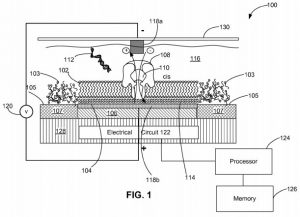
Figure 1 of U.S. Patent No. 8,324,914.
In the final days of 2016, the Regents of the University of California, which governs the University of California (UC) system, filed a lawsuit against a former graduate student from UC Santa Cruz (UCSC). At the center of the legal spat is the proper assignation of a series of patents covering DNA sequencing technologies, which UC alleges were developed while the inventor was under an agreement obliging him to assign those patents to UC. The suit has been filed in the U.S. District Court for the Northern District of California (N.D. Cal.).
The complaint filed by UC names Roger Jinteh Arrigo Chen, a graduate student at UCSC between October 2005 and January 2008, as the main defendant in the case. UC alleges that Chen’s work at the UCSC biophysics laboratory was conducted under the terms of an oath which reads, in part:
“I acknowledge my obligation to assign inventions and patents that I conceive or develop while employed by University or during the course of my utilization of any University research facilities or any connection with my use of gift, grant, or contract research funds received through the University. I further acknowledge my obligation to promptly report and fully disclose the conception and/or reduction to practice of potentially patentable inventions to the Office of Technology Transfer or authorized Licensing office.”
Chen’s work in the UCSC biophysics lab led to the development of a series of inventions related to individually addressable nanopores, which can be used to characterize a nucleic acid sequence in a nucleic acid molecule. These inventions were described in patent applications filed by UC with the U.S. Patent and Trademark Office (USPTO) listing Chen as an inventor, including:
- U.S. Patent Application No. 20140034517, titled Compositions, Devices, Systems, and Methods for Using a Nanopore. It claims a method for sequencing polynucleotides by providing a chip with a plurality of individually addressable nanopores formed in a membrane, applying a voltage to capture polynucleotides in the nanopores and employing a sequencing device having a large array of integrated circuits and a digital logic circuit with each nanopore.
- U.S. Patent Application No. 20140346059, same title as ‘517 patent application. It claims a similar method for nucleic acid sequencing which is related to molecular computational devices useful for diagnosing cancer, autoimmune diseases or cell cycle disorders.
- U.S. Patent Application No. 20160040230, same title as ‘517 patent application. It also claims a method of nucleic acid sequencing using a processor chip which overcomes previous disadvantages in controlling the rate at which a target polynucleotide is analyzed.
UC filed these as provisional patent applications and then asked Chen to execute a declaration directed to the patent applications, which he allegedly refused to do going back to 2009. In response to a request for executing a declaration sent in January 2014, Chen allegedly asked to be provided with a copy of the claims from the patent applications. In response to receiving those claims, Chen allegedly notified UC in March 2014 that he did not believe he contributed to the material in the claims.
Instead of following his contractual obligations to assign his invention to UC, Chen allegedly filed patent applications and received patent grants assigned to medical technology firm Genia Technologies, a company he founded in March 2009 after leaving UCSC. UC charges that Genia’s business model is based directly on the inventions Chen developed at UCSC. UC identifies four patents covering these technologies which have been assigned by USPTO to Genia, including:
- U.S. Patent No. 8324914, titled Systems and Methods for Characterizing a Molecule. It claims a method of characterizing a molecule by trapping a portion of the molecule in an individually addressable nanopores within a nanopore array, applying a variable voltage across the nanopore to move the trapped molecule portion and then characterizing the molecule based on the electrical stimulus required to effect movement.
- U.S. Patent No. 8461854, same title as ‘914 patent. It claims a similar method for nucleic acid sequencing which enables improved techniques for DNA analysis.
UC’s lawsuit notes that Chen, through Genia, has been able to reap great financial gain thanks to obtaining these intellectual property assets. In June 2014, after the ‘914 and ‘854 patents were assigned to Genia, Swiss healthcare company Roche Holding AG (VTX:ROG) acquired Genia in a conditional acquisition which could have paid shareholders up to $350 million, $125 million of which was guaranteed.
UC’s suit includes six claims for relief including claims for correction of inventorship under 35 U.S.C. Section 256, declaration of patent ownership, breach of contract and imposition of a constructive trust on Genia’s patents and any portion of Roche’s acquisition payment attributable to the Genia patents. UC also includes claims made under California state law, including breach of the implied contract of good faith and fair dealing as well as conversion.

![[IPWatchdog Logo]](https://ipwatchdog.com/wp-content/themes/IPWatchdog%20-%202023/assets/images/temp/logo-small@2x.png)

![[Advertisement]](https://ipwatchdog.com/wp-content/uploads/2024/04/Patent-Litigation-Masters-2024-sidebar-early-bird-ends-Apr-21-last-chance-700x500-1.jpg)

![[Advertisement]](https://ipwatchdog.com/wp-content/uploads/2021/12/WEBINAR-336-x-280-px.png)
![[Advertisement]](https://ipwatchdog.com/wp-content/uploads/2021/12/2021-Patent-Practice-on-Demand-recorded-Feb-2021-336-x-280.jpg)
![[Advertisement]](https://ipwatchdog.com/wp-content/uploads/2021/12/Ad-4-The-Invent-Patent-System™.png)







Join the Discussion
One comment so far.
JAMES K. POOLE
March 27, 2017 03:14 pmInteresting article, but “assignment” is the correct term. Please check your dictionary for the meaning of “assignation!”